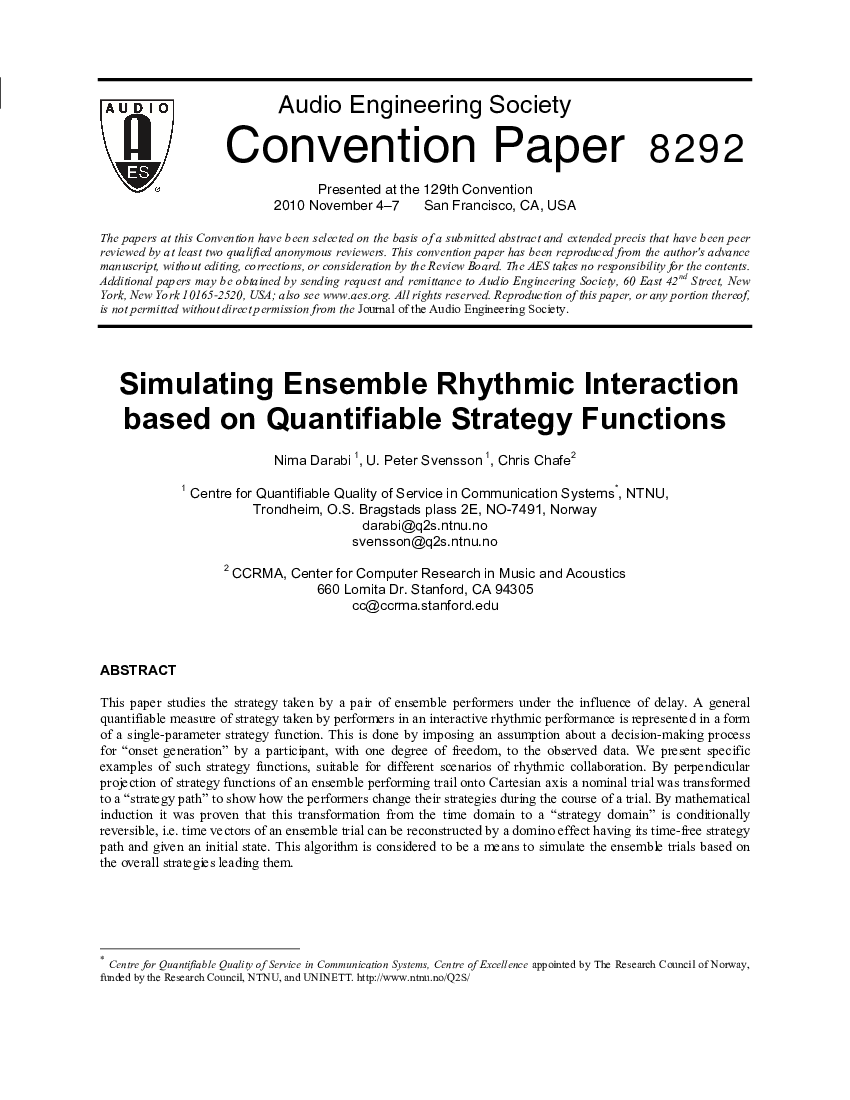Home / Publications / E-library page
You are currently logged in as an
Institutional Subscriber.
If you would like to logout,
please click on the button below.
Home / Publications / E-library page
Only AES members and Institutional Journal Subscribers can download
This paper studies the strategy taken by a pair of ensemble performers under the influence of delay. A general quantifiable measure of strategy taken by performers in an interactive rhythmic performance is represented in a form of a single-parameter strategy function. This is done by imposing an assumption about a decision-making process for “onset generation” by a participant, with one degree of freedom, to the observed data. We present specific examples of such strategy functions, suitable for different scenarios of rhythmic collaboration. By perpendicular projection of strategy functions of an ensemble performing trail onto Cartesian axis a nominal trial was transformed to a “strategy path” to show how the performers change their strategies during the course of a trial. By mathematical induction it was proven that this transformation from the time domain to a “strategy domain” is conditionally reversible, i.e. time vectors of an ensemble trial can be reconstructed by a domino effect having its time-free strategy path and given an initial state. This algorithm is considered to be a means to simulate the ensemble trials based on the overall strategies leading them.
Author (s): Chafe, Chris; Darabi, Nima; Svensson, U. Peter
Affiliation:
CCRMA, Stanford University, Stanford, CA, USA; Norwegian University of Science and Technology, Tronndheim, Norway
(See document for exact affiliation information.)
AES Convention: 129
Paper Number:8292
Publication Date:
2010-11-06
Import into BibTeX
Session subject:
Perception and Subjective Evaluation of Audio
Permalink: https://aes2.org/publications/elibrary-page/?id=15714
(484KB)
Click to purchase paper as a non-member or login as an AES member. If your company or school subscribes to the E-Library then switch to the institutional version. If you are not an AES member Join the AES. If you need to check your member status, login to the Member Portal.

Chafe, Chris; Darabi, Nima; Svensson, U. Peter; 2010; Simulating Ensemble Rhythmic Interaction Based on Quantifiable Strategy Functions [PDF]; CCRMA, Stanford University, Stanford, CA, USA; Norwegian University of Science and Technology, Tronndheim, Norway; Paper 8292; Available from: https://aes2.org/publications/elibrary-page/?id=15714
Chafe, Chris; Darabi, Nima; Svensson, U. Peter; Simulating Ensemble Rhythmic Interaction Based on Quantifiable Strategy Functions [PDF]; CCRMA, Stanford University, Stanford, CA, USA; Norwegian University of Science and Technology, Tronndheim, Norway; Paper 8292; 2010 Available: https://aes2.org/publications/elibrary-page/?id=15714